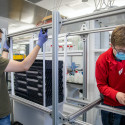Two new UW–Madison-led studies inform outlook on scaling of carbon removal technologies
Carbon dioxide removal (CDR) technologies that could be critical tools to combat climate change have developed in line with other technologies from the last century. However, according to new studies led by Gregory Nemet, a professor at the University of Wisconsin–Madison, these technologies need to develop faster to meet policy targets aimed at limiting global warming.
As policymakers, researchers and climate activists from around the world prepare to meet for the UN Climate Change Conference beginning on Nov. 30, one lingering question is whether climate technologies are developing and scaling quickly enough to meet the demands of the Paris Agreement.

Greg Nemet
New research led by Nemet, who is a professor in the La Follette School of Public Affairs, finds that novel CDR methods need to scale at a much faster rate to meet the Paris Agreement’s temperature goal of limiting warming to 2 or 1.5 degrees Celsius. That goal would require removing hundreds of gigatons of carbon dioxide from the atmosphere over the course of the century, making the scaling of novel CDR technologies particularly important.
CDR involves capturing carbon dioxide from the atmosphere and storing it in a variety of ways. Examples of conventional CDR include reforestation, wetland restoration and improved forest management. All other CDR methods have only been deployed at small scale and are collectively known as novel CDR. Examples include bioenergy with carbon capture and sequestration, direct air carbon capture and storage, and biochar. These new methods may be able to offer more durable carbon storage than conventional methods that rely on trees and soils.
In one of their recent papers published Oct. 30 in Communications, Earth & Environment, Nemet and his research team debut the Historical Adoption of TeCHnology (HATCH) dataset — an innovative project that tracks and analyzes a variety of agricultural, industrial and consumer technologies adopted over the past century that can provide insight into the scale-up of new technologies such as carbon removal.
The study analyzed the emergence and growth of 148 technologies across 11 categories going back to the early 20th century. It then cross-referenced this data with model CDR scenarios established by the Intergovernmental Panel on Climate Change (IPCC), company announcements of CDR scale-up plans, and CDR targets in policy announcements.
While the paper found evidence that the required scale-up of carbon removal technologies fits within the historical range of previous efforts, company announcements and government targets implied there would be much faster growth than the historical record and IPCC CDR modeled scenarios.
“The scale-up rates needed for carbon removal to meet the 2- and 1.5-degree Celsius targets are within the range of historical experience, even if at the high end,” says Nemet. “We can learn from that experience to facilitate getting carbon removal to climate-relevant scale over the next three decades.”
In another paper published Nov. 15 in Joule, Nemet and his research team find that 2 gigatons of carbon dioxide removal per year is currently taking place. Nearly all of that removal is accomplished by planting more trees and only 0.1% from novel CDR.
This is all despite modeling scenarios that show that we need to remove hundreds of gigatons of carbon dioxide from the atmosphere over the course of the century to meet the Paris Agreement and ensure the sustained wellbeing of our planet.
The study finds that virtually all scenarios that limit warming to 1.5 or 2 degrees Celsius require novel CDR. On average, scenarios increase novel CDR by a factor of 1,300 by mid-century.
By looking at the period of time between when a technology is introduced to the market and when rapid scale-up of its production occurs — called the formative phase — the paper suggests that this part of the process for direct air carbon capture and storage and other novel CDR methods must accelerate to meet the needs of a warming planet. Speeding up the innovation that occurs during this phase to begin a higher volume of production sooner could help improve technology adoption.
“To become climate relevant, the formative phases for air filter systems and other novel methods of carbon removal need to be at least as active as the fastest historical analogues,” says Jan Minx, head of the Mercator Research Institute on Global Commons and Climate Change working group Applied Sustainability Science and a co-author of both studies. “This will require more serious commitments toward novel removal technologies than are currently in place. The required levels will only be feasible if we see substantial development of novel CDR’s formative phase in the next 15 years.”
The results of these studies will also be included in the forthcoming 2023 UN Emissions Gap Report, which includes a chapter on carbon removal with contributions by Minx and Nemet.



